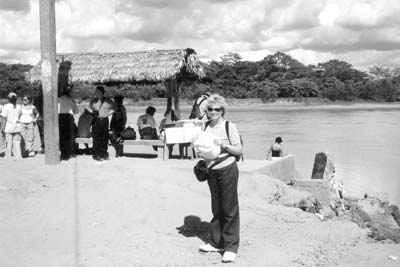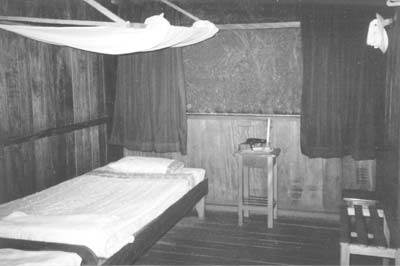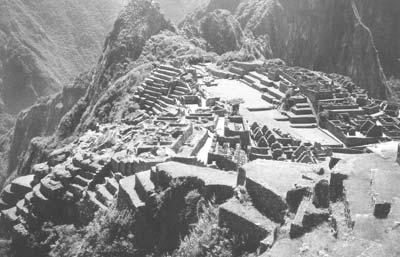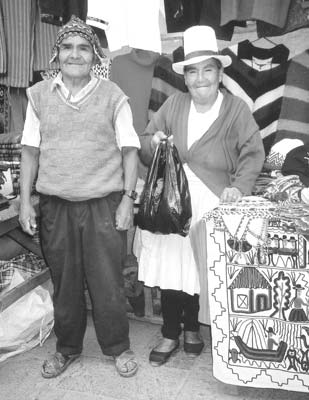On a course to adventure — delving into the Peruvian rainforest
by Patricia Arrigoni, Fairfax, CA
From a treetop deep in the jungles of Peru, a tiny brown monkey stares down at me with curiosity. I aim my binoculars and stare back into his intense, dark eyes. We check each other out for a couple of minutes, then he is gone, swinging with ease to the next tree.
But there were more animals to discover on this May ’03 trip to Peru, like the saddle-back tamarin and the three-toed sloth, plus a selection of beautiful birds.
A complicated journey
I was one of a group of three American travel writers and three photographers on a familiarization trip, and while the primary reason for visiting Peru was to see Incan ruins, this side trip to Sandoval Lake Lodge, deep in the Peruvian jungle (or rainforest), turned out to be an adventure on its own. The experience of just getting to the lodge and Sandoval Lake was unexpected.
To begin, it required a flight from Lima to Cusco, then another to Puerto Maldonado. From the airport we were taken by bus to Tambopata Harbor, where we were asked to leave some of our belongings for the few days we would be in the jungle. In a small building run by the national park, I changed to cooler clothes and tore apart my luggage, cramming what I thought I’d need into a backpack.
Our bus then took us to the Tambopata River, which flows into the Madre de Dios River, all part of the Amazon River Basin and drainage system. We boarded a launch for a 35-minute ride upriver. The temperature was in the 90s and the breeze off the water felt wonderful.
We landed at the Sandoval port and climbed up a crumbling cliff, where we picked up a 2-mile path that led to Sandoval Lake. It was the middle of May and the rainy season was just ending, so I lathered up with mosquito repellent and suntan lotion.
Our porters piled the luggage into a cart and began pushing and pulling it down the muddy path. (On the way back, the whole mess of luggage turned over, covering everyone’s suitcases and backpacks in thick Peruvian mud.) Two of the women rode in on a rigged-up metal “rickshaw,” pulled and pushed by two young men.
At the end of the trail we were loaded into a long canoe and paddled through heavy jungle for about 15 minutes. I felt like I was living in the film “The African Queen.” At the end, we finally arrived at Sandoval Lake.
On to the lodge
Next we climbed onto a “catamaran,” actually a square, wooden platform with benches and rails that sat atop two canoes. No motors are allowed on this lake, so the canoes were paddled by locals. It took about 20 minutes to arrive at our final destination, the lodge.
The lodge itself is located high on a bluff, up at least three flights of wooden stairs. In all, it had taken us three hours to get there from Puerto Maldonado.
Sandoval Lake Lodge (Manuel Bano n461, San Isidro, Puerto Maldonado, Lima, Peru; phone 011 51 1 440 20222 or 011 51 82 963 3329 or fax 011 51 1 422 9225), at $85 daily including meals, is located in the Tambopata-Madidi wilderness. It was built seven years ago when the lake was proclaimed a nature reserve. Only the Mijea family, who owned the land originally, still live around the lake and are allowed to fish for their own consumption.
The lodge was built of driftwood as one single unit, with rooms divided by walls but no ceilings. High above is a thatched roof.
My room contained two bunk beds, covered with mosquito netting, as well as two small tables and a fan. Each room had a private bathroom with a shower heated by propane, plus a flush toilet and a sink with cold water. A generator turned on electricity at certain peak hours.
The lodge has 25 rooms with private baths and can house 57 guests. It stays open all year, even during the rainy season. In 2002 there were 2,300 visitors, mainly bird-watchers.
I found the food at Sandoval Lake Lodge quite tasty, with a good variety of dishes. One breakfast consisted of eggs and toast and another of a single large pancake. Fresh fruit was always available. For lunch we enjoyed rice and chicken cooked inside a banana leaf.
Area wildlife
Our guide was a Peruvian named Enrique (Kike) Castillo, a zoologist who studied at the zoo on the island of Jersey. He has also lived in London and New York City.
Kike explained that there are about 800 species of birds living around the lake, including many that are endangered. It has one of the highest populations of birds in Peru.
Our guide was successful in showing us red-bellied macaws, mealy parrots, hoatzins, crimson-crested woodpeckers, a green kingfisher, green ibis and scaled pigeons. In addition, we saw yellow-headed vultures, three yellow-spotted side-necked turtles and a black caiman. This crocodile-looking creature, one of about 400 in the lake, is approximately five meters long and has long jaws. We could see their eyes looking at us out of the water.
In the 24 hours after our arrival, our little group had already seen five out of the six monkey species in this rainforest, including red squirrel monkeys, howlers, spiders and the brown capuchin. We never did see the wide-eyed owl monkeys, which are noctturnal. (They wait for the generator at the camp to go off at the lodge around 10:30 p.m. before slipping in to eat papayas and bananas left out for them.)
About the lodge
Back at camp, we learned more about the lodge. We were in southeast Peru, very close to the Bolivian border. Following Conservation International’s move to protect this land, the Parque Nacional del Manu, covering 2,000 acres, was created in 1966. The organization also bought 46 hectares, 41% of which went to the Mijea clan, with the rest set aside for the lodge and conservation. The lodge is now owned by a nonprofit conservation group, Peru Verde, and five families of indigenous Brazil nut harvesters.
The well-run Sandoval Lake Lodge serves the purpose of housing nature lovers, especially “birders,” who visit from all over the world. The Tambopata-Madidi wilderness area in which the lodge is located, just south of Manu, is an outstanding example of the conservation progress now being made in Peru.
Our trip to Sandoval Lake was followed by visits to Machu Picchu, the Sacred Valley of the Incas, the famous Pisac market and the cities of Cusco and Lima. All were arranged by LanChile Vacations and were completed within a week.
Preparing for your trip
High season at Sandoval Lake Lodge is June to August, the dry season, which has temperatures running in the 90s and 100s.
The rainy season is October to April, with the heaviest rain in January and February. Temperatures run from 30°F at night to 64°F during the day.
We were required to have a yellow fever shot, and some visitors took malaria pills. Mosquito repellent and suntan lotion are musts. We were also told to take a hat, camera, film and binoculars.
I flew LanChile (phone 800/735-5526 or visit www.lanchile.com) in an A-340 (Airbus) for the 8-hour journey from Los Angeles to Lima, then continued on smaller airplanes (A-320s, with three seats on each side) from Lima to Cusco and Puerto Maldonado. The service was always excellent and the food good. There were no business- or first-class seats on the A-320s, but seats were assigned.
LanChile Vacations (320 E. 900 South, Salt Lake City, Utah 84111; phone 877/219-0345 or visit www.lanchilevacations.com), which is owned by LanChile Airlines, offers a wide variety of itineraries for group travel throughout South America and can arrange small, private tours using a van or car with a driver. (They recommend that visitors do not try to drive themselves.) They arranged the tour for our group, and everything was done with utmost efficiency. The guides were first class.
Pat Arrigoni was a guest of LanChile Vacations.





